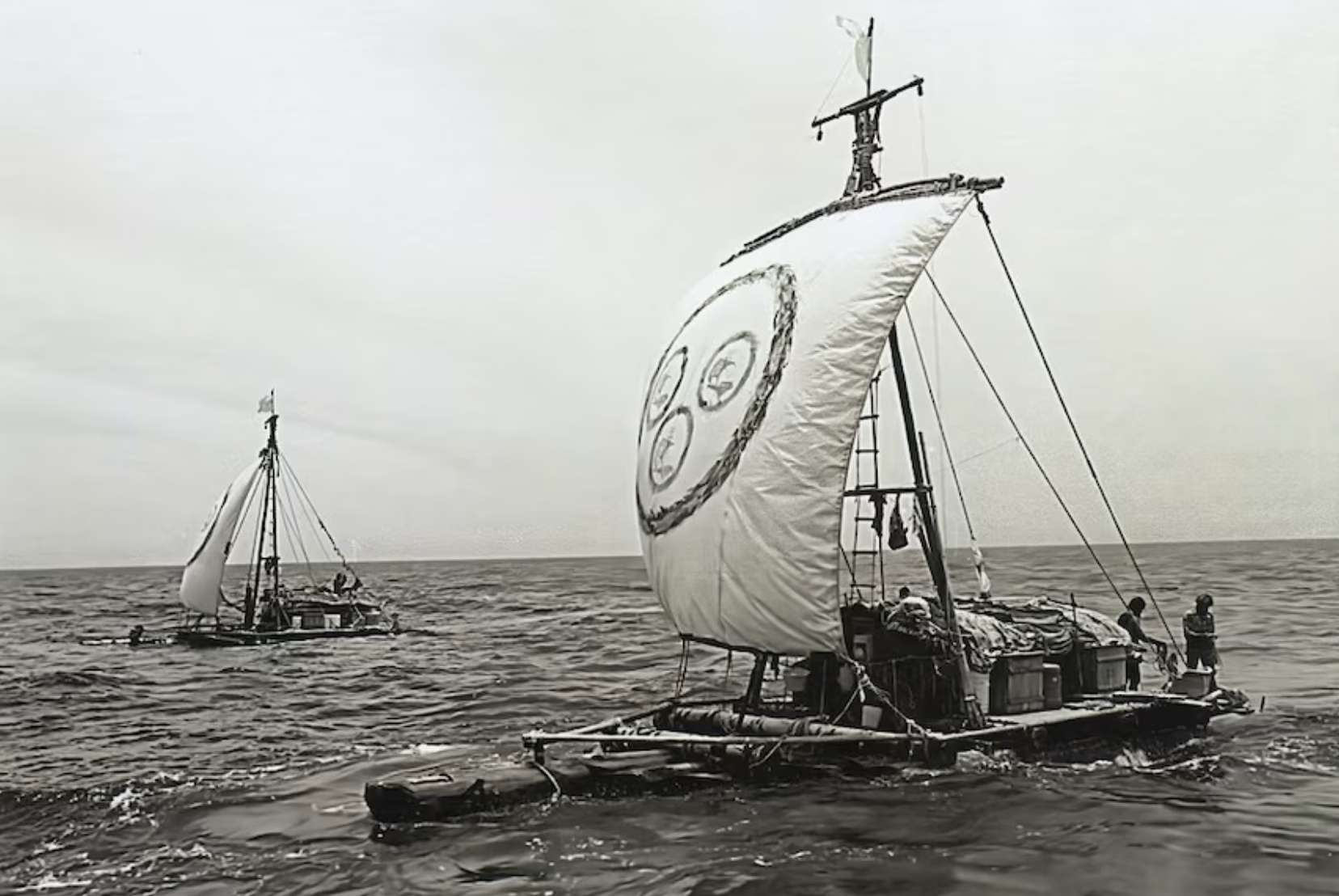50 Years after arriving in Ballina
From ABC North Coast By Elloise Farrow-Smith and Julie Ray
An epic 1970s raft journey from Ecuador to Ballina still holds world record.
Four of the adventurers and a cat on one of the Las Balsas rafts at sea, 1973.(Supplied: Ballina Naval and Maritime Museum/John Carnemolla)
It's a salty tale of odyssean proportions, yet most Australians are unaware of the adventure of 12 men, three balsawood rafts, two monkeys, and a couple of cats that in 1973 became the world's longest raft journey.
The trio of rafts travelled 14,000 kilometres across the Pacific Ocean from Ecuador to eventually and accidentally arrive at Ballina on Australia's east coast.
It wasn't the first time long-range raft travel had been tested in open seas — in 1947, the Kon-Tiki, skippered by Norwegian explorer Thor Heyerdahl, sailed 8,000km from South America to the Polynesian Islands.
Spanish explorer Captain Vital Alsar wanted to double that journey and bolster Heyerdahl's theory that the ancient civilisations of South America could have traversed the Pacific in such a way in the past and potentially populated its islands.
Mr Alsar attempted a trip in 1970 in a single raft, but wanted to attempt the feat with three rafts travelling in formation.
Two of the Las Balsas rafts at sea, 1973
Captain Alsar recruited a crew of 11 men from Canada, the United States, Chile, Mexico, and Ecuador.
Original crewman Fernand Robichaud from Canada said the crew faced storms, a lack of drinking water and doldrums, but it was the monkeys — a departing gift from the locals — that were the biggest regret.
"Monkeys are too much like humans. They watch you tie ropes, but in the middle of a storm he can be trying to undo one of your ropes because he thinks he's helping out," Mr Robichaud says.
"So they can be incredibly annoying and dangerous, especially when I caught one trying to throw our compass overboard. We only had one compass."
There was a lot at stake.
"We had one little two-man rubber dinghy, that's not a life raft for 12 people," Mr Robichaud says.
There were no life jackets onboard. The balsawood rafts themselves had high buoyancy, due mostly to a little-known fact about the female balsa tree. Ron Creber at the Ballina Maritime Museum is the custodian of the only surviving raft from the voyage.
"Most people remember balsawood from when they were young children. They made planes and built boats out of very light timber; that particular wood that we use to make those models is the sapwood," he says.
"The tree is actually a hardwood, but it has a very large sapwood around it.
"The trees that they had to use were female trees, which they had to cut down at the full moon because the sap content then is at its highest and keeps it afloat."
The rafts were assembled in about two and a half weeks.(Supplied: Ballina Naval and Maritime Museum)
The crew travelled into the Ecuadorian forest and felled the logs, floating them downriver to the local port. There they made models before constructing the full-sized rafts.
"That was a very good idea to practice on models beforehand because they managed to build those rafts in about two and a half weeks," Mr Creber says.
The journey's 50-year anniversary is being celebrated at the museum this week. Mr Creber says sailing the boat would not have been as easy as other marine craft.
Two of the Las Balsas rafts make their way up the Richmond River to Ballina.(Supplied: Ballina Naval and Maritime Museum)
"They didn't have a rudder, they had keel boards and they go through the logs. [The crew] could move them slightly up and down and they could move the sail to port and starboard to adjust their course."
Fernand Robichaud has spent a lot of his life on the sea but said sailing on a raft was unique.
"It's not like you can pull it in the harbour and then take off again, it's pretty much one direction."
The journey mostly relied on the current that sweeps across the Pacific.
Crowds watch as one of the Las Balsas rafts makes its way to Ballina.(Supplied: Ballina Naval and Maritime Museum/David Harrison)
The original plan was to arrive at Mooloolaba in Queensland.
After six months at sea, the crew indeed sighted their destination, but before they knew it the three rafts were picked up by a different current and were travelling south.
As the rafts travelled in the shipping line there was much discussion about where to end the journey safely.
With the help of the navy, the rafts were towed into Ballina. Mr Robichaud believes the crew was lucky to survive the journey.
"We could have easily lost people. All the time you're by yourself on the sail everybody else is sleeping and you just do the wrong move or you get a wave on the side you can easily get dragged overboard," Mr Robichaud says.
The safety backup was a rope that hung off the back of the rafts.
One of the adventuring sailors taking a break on the roof of the hut on the Las Balsas raft.(Supplied: Ballina Naval and Maritime Museum)
"If you don't grab that rope when you fall overboard it's bye-bye because there's no way in the world you can turn the raft around and pick anybody up," Mr Robichaud says. Then there were storms.
"We were in the eye of a cyclone once. There were some interesting moments then," he says.
The crew faced waves of more than 12 metres in height.
One of the ill-fated monkeys from the 1973 Las Balsas expedition.(Supplied: Fernand Robichaud)
And the monkeys?
"Sadly, one got caught in between bins during a storm and got crushed," Mr Robichaud says. The other one got an infection and we didn't really know how to fix it."
But the cats and the men lived to tell the tale.







